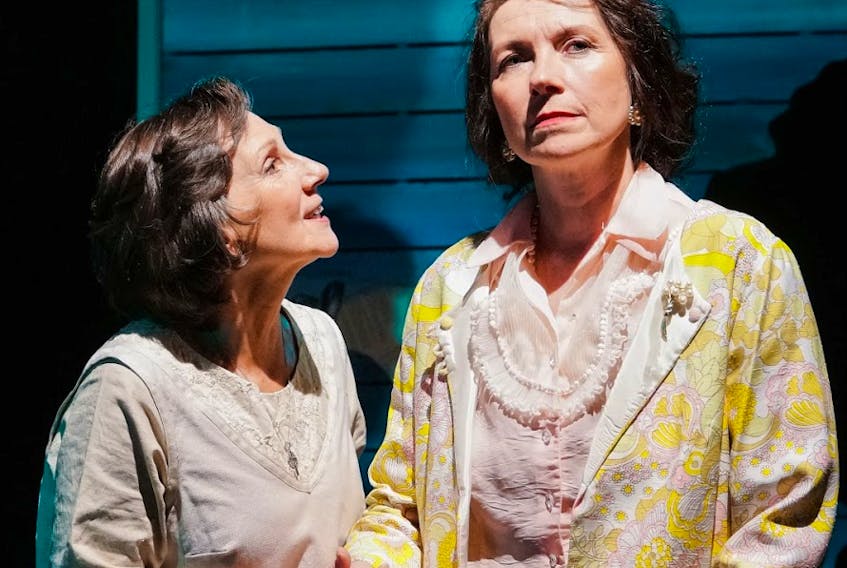It’s the late 1960s in an elegant house on Rennies Mill Road.
A woman, infirmed and silenced by Parkinson’s, is wheeled in by her attendant, Mary.
“I’m going to park you right here, my darling.”
Through Mary’s chatter we learn the home is being sold, and, from the Beatles song briefly heard on the radio, that it’s the 1960s. The woman is Margaret Duley (Ruth Lawrence), Newfoundland and Labrador’s first female novelist of the 20th century, with four successful books to her credit.

But words are beyond her now.
After Mary (Amy House) applies Margaret’s signature crimson red lipstick she bustles off to deal with some domestic transaction. But Margaret is not alone for long.
A girl (Mallory Fisher) enters, in a long white dress, clapping a flamenco beat.
“I carry the sun in my pockets,” she tells Margaret, who is able to increasingly focus on her. When the girl exits, Margaret rises, folds away her wheelchair, changes her clothes, dons new jewelry, and adjusts her makeup to set the scene for a pre-Second World War cocktail party.
This has been assembled to celebrate her debut launch of “The Eyes of the Gull.” Mary, now a maid, mixes snazzy highballs. Soon they are joined by Margaret’s brother, Nelson (Torquil Colbo); gentle, witty, melancholic. Guests arrive: Lila (Marie Jones), and Paul (Darryl Hopkins), a cosmopolitan, somewhat over-frank couple. Another man, Walter (Edward Daranyi), loiters in the background, apparently unnoticed by the others.
Conversation swirls around the book, the coming war: lots of sharp, quick, repartee. But Margaret is not entirely present: there are brief moments of what Mary calls her “spells.”
It also emerges that she, and she alone, can see Walter, a romantic figure from her past. Whoever he is, he’s not with her now: as she tells her company, “I am the perfect middle-aged spinster. There is a freedom in it, Lila.”
Margaret’s freedom includes the family resources allowing her time to write – although her mother, the formidable Tryphena (Donna Butt), would much prefer she do just about anything else. (Writing is so … public.) She also travels, living at times in London and Montreal. Her relationship to Newfoundland has its “ins and outs,” and she keeps away for long periods (also her publishers were British and American, not Canadian).
The action progresses, marked by the recurring sound of a clock ticking. There’s also musical accompaniment, sometimes directly from a gramophone, for example of “La Vie en Rose.”
Director Jenn Deon keeps things tight, alert, and crisp.
Hopkins and Jones reappear as different characters, and Christopher Dunne steps out of one of Margaret’s own fictions. Mary is a slightly different character in each scenario, though always a devoted retainer.
Playwright Berni Stapleton has scripted rich-as-torte layers of narrative. For example, Nelson, though he appeared able, was in reality as well as in the play deemed medically unfit for service in the First World War, and he was white-feathered, which greatly shamed him.
At another point, a scene from “The Eyes of the Gull” animates the stage. Even if we haven’t read the novel, this isn’t confusing because it has been signaled to us by previous lines of dialogue – Tryphena, for example, lamenting that she’s presumed to have inspired the mother in the novel and quoting dialogue the fictional maternal presence later delivers. Also, there are several references to Mary having been lost in the woods as a child, and possibly fairy-led, an experience Duley embedded in “Cold Pastoral.” That is a true story, and made international headlines at the time, although that woman did not grow up to work for Duley.
Just as an Impressionist painting that is all about the paint, this is a play that is all about being a play.
First of all, the casting is excellent, everybody’s spot on, and Lawrence has never been better. There are moments and devices that are simply “theatrical,” with actors freezing into tableaus, or Lawrence’s changing costume in front of the audience.
The set is gorgeous, too. The audience really commented on it. Curlicued chairs and a settee are configured against a jigsaw wall painted with a seascape. There’s evidence of both wealth and fragmentation.
Set and lighting design is by Holly Meyer-Dymny, costumes by Kelly Bruton, and sound design by Kathryn Burke.
“The Haunting of Margaret Duley” continues at the LSPU Hall Saturday night and Sunday afternoon. It’s a one-act piece, running about 100 minutes.
What haunts Margaret Duley? Her writing, her loves, her family. Through deft handling by all, these ghosts sway the audience, too.
Joan Sullivan is editor of Newfoundland Quarterly magazine. She reviews both fiction and non-fiction for The Telegram.
MORE FROM JOAN SULLIVAN









